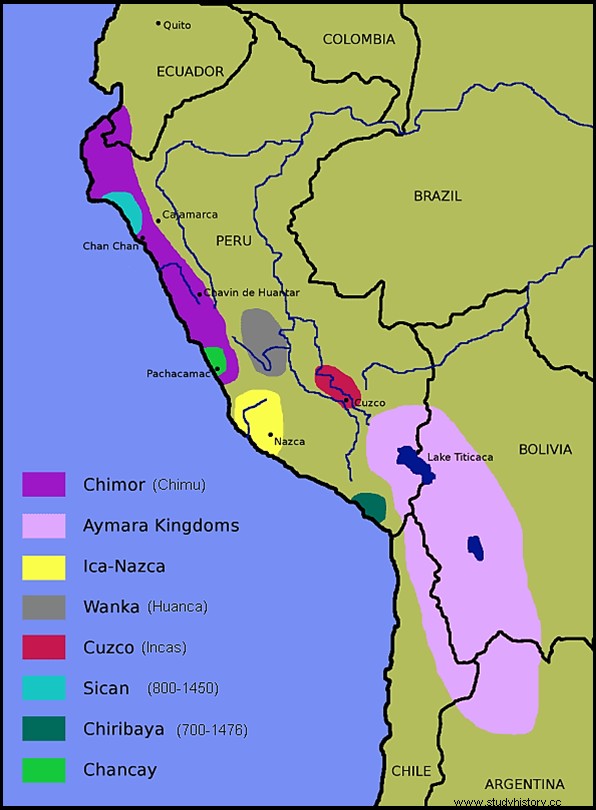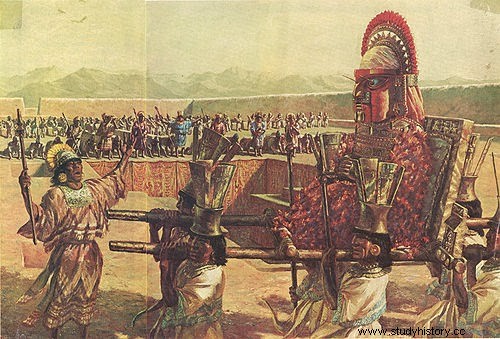 Kingdoms and lordships that emerged after the fall of the Wari empire (9th-13th centuries) After the decomposition of the Wari imperial system; that is to say, when the centralist hegemony of Viñaque's military over the regions under his administration was broken, the control of the head cities of the region disintegrated, either due to the internal rebellions of their administrators or due to external invasions (yaros and chancas). This caused the development of a new regional period which they call the Late Intermediate or Second Regional Development. of the Chimu Kingdom. The Late Intermediate peoples retained many of the Wari's construction and urban planning techniques and maintained some of their religious beliefs. However, during this period their own regional characteristics also began to develop. Populations increased and consequently the fight for farmland was greater. Thus, wars between kingdoms and regional lordships became a common activity. From then on, the great concern of the rulers of that time was to build cities and fortresses to defend themselves. In the case of the Late Intermediate, the cultures and kingdoms that flourished in the fragmented regions of the Wari horizon preserved the rural urban centers or administrative cities, as the main axes of their economic, political and craft organization. We can mention the importance of the cities of Chan Chan (Chimú), Vilcashuamán (Chanca), Cusco (Quechua), Tambo de Mora (Chincha), Chucuito, Hatun Colla (Aymara kingdoms). From these cities, the regional ruling classes centralized their powers. The main regional cultures and kingdoms that flourished during the Late Intermediate Period (11th to 15th centuries) were:
Kingdoms and lordships that emerged after the fall of the Wari empire (9th-13th centuries) After the decomposition of the Wari imperial system; that is to say, when the centralist hegemony of Viñaque's military over the regions under his administration was broken, the control of the head cities of the region disintegrated, either due to the internal rebellions of their administrators or due to external invasions (yaros and chancas). This caused the development of a new regional period which they call the Late Intermediate or Second Regional Development. of the Chimu Kingdom. The Late Intermediate peoples retained many of the Wari's construction and urban planning techniques and maintained some of their religious beliefs. However, during this period their own regional characteristics also began to develop. Populations increased and consequently the fight for farmland was greater. Thus, wars between kingdoms and regional lordships became a common activity. From then on, the great concern of the rulers of that time was to build cities and fortresses to defend themselves. In the case of the Late Intermediate, the cultures and kingdoms that flourished in the fragmented regions of the Wari horizon preserved the rural urban centers or administrative cities, as the main axes of their economic, political and craft organization. We can mention the importance of the cities of Chan Chan (Chimú), Vilcashuamán (Chanca), Cusco (Quechua), Tambo de Mora (Chincha), Chucuito, Hatun Colla (Aymara kingdoms). From these cities, the regional ruling classes centralized their powers. The main regional cultures and kingdoms that flourished during the Late Intermediate Period (11th to 15th centuries) were:Ethnic groups, kingdoms and dominions after Wari
 * The Sicán were annexed by the Chimú before the Inca expansion .
* The Sicán were annexed by the Chimú before the Inca expansion .From these cultural developments, from the second great regionalization or Late Intermediate, we are going to study the expansive character that the dominant classes of some societies had, in the historical period between the 13th, 14th and 14th centuries. XV (d.n.e.), which are:1. Chimú 2. Chincha 3. Chanca 4. Huanca5. Quechua
READING "CHIMU SOCIETY" This rich and luxurious society, with its aristocracy full of privileges, was created by military conquests, but was maintained thanks to an elaborate ideological and police apparatus, made of promises and punishments. The Chimú Law was as severe as the Inca Law. The sacrilegious was buried alive, the adulterer overthrown. But above all, the greatest care was taken to punish crimes against private property. In this way, the nobility defended their own interests. When a robbery occurred, the Chimú lords and priests maintained that the entire Universe had been turned upside down. The gods were irritated by this sin (not a simple crime) against property. Different religious ceremonies were then held until the thief was found, who was punished to death.
The Chimú State was also not tolerant of error or incapacity. The doctor who, out of ignorance, did not cure a patient was sentenced to die along with his patient.
The ultimate justification for this social order rested on religious beliefs. The princes, like the peasants, were devout believers. All the activities and phenomena of their daily life were under the protection of some divinity. A huaca (Carquiña) protected against various skin diseases. Another was called Piojosa (Mollep).
In the sky, numerous stars, constellations and celestial bodies served as guides for the Chimús in their various economic practices. It is possible (although some deny it) that above all the minor gods they recognized a Supreme Being Aiapaec and below him the feminine and maternal principle of fertility represented by SI "name of the Moon".
 CHIMU RITUAL
CHIMU RITUAL 